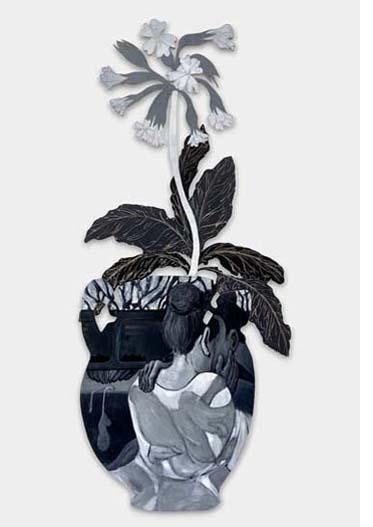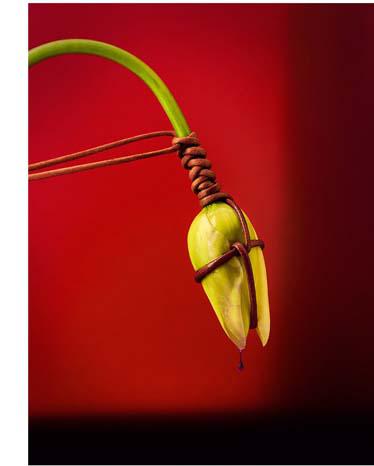Weekend Update: Flowers / Gardens in Art
The winter chill won’t let go here in New York City so I looked around for inspiration from artists in the garden. This month, you can warm your spirits and let your imagination soar with six artists whose exhibitions will give you a lift—or scare you into a more enlightened climate awareness.
Continuing: Mimi Park | Dawning: dust, seeds, Coplees at Lubov
South Korean artist Mimi Park’s new exhibition, “Dawning: dust, seeds, Coplees,” takes on the theme of H. G. Wells’s 1896 science-fiction novel The Island of Doctor Moreau, in which a shipwrecked protagonist finds himself on the titular landmass, which is inhabited by the abominable creations of a mad scientist whose interspecies experiments are a haunting metaphor for man’s disregard and cruelty toward nature.
Live seedlings in various stages of growth sprout from a pulpy Pangea-like landmass on the gallery’s floor—a carpet of lush greenery with a meticulously crafted topography of rolling vistas, valleys, and basins. The inhabitants of this wondrous land include an array of automated bots, some as small as a matchbox, who live alongside larger bots with humanoid features, reminiscent of Snow White’s dwarfs had they sprung from a cyberpunk noir written by Philip K. Dick. In an adjacent room, the building blocks of Park’s kingdom are categorically arranged upon the floor into an exhaustive indexical display: Bits of string, copper wire, buttons, glass trinkets, bags of glitter, computer motherboards, and more are laid out with surgical precision.
In the main gallery, a single misguided step may result in the immediate death of a Coplee, one of the twelve fluttering droids that comprise Coplee Swarm, 2022. Each one is no larger than a monarch butterfly and fashioned from toothbrushes, pipe cleaners, and electric motors. Another droid, Bristle Bot, 2022, trudges atop a pair of toilet-bowl scrubbers, its exposed wiring surrounding a vibrating pool of water on its back. Watch long enough and you may see this poor creature erroneously bludgeon itself by repeatedly smashing into a wall, its metallic screech begging onlookers to end its crude existence. Wait even longer and this entire world of lush greenery will eventually decay into a pungent pile of compost and metal scraps.
Through April 16 at Lubov, 5 East Broadway #402, New York, NY
Continuing: Luján Pérez: With Our Roots Entwined at Kapp Kapp
Pérez’s most recent body of work continues her navigation between painting, printmaking, and sculpture through a collective retelling of lovers throughout art history.
Instinctually incorporating her vast familiarity with herbal healing and personal histories of nomadic life between Spain and the United States, Pérez’s visual language considers and confronts the past, offering a deeply connected reinterpretation for her ongoing lovers’ anthology. Whether fictitious plant creations nodding both to their potential healing powers and their ability to kill or nostalgia-steeped representations of memory and the unconscious, Pérez’s charm is her ability to digest and divulge these stories anew.
Beginning with a glossary of reference images of works ranging from Diego Rivera to Nicole Eisenman, Arthur Boyd to 19th century lovers entombed in Milan’s Cimitero Monumentale, Pérez then interpolates these compositions with oil paint onto sheets of mylar in her signature black, white, and grayscale palette. Translating the language of their original creator into her own, Pérez maintains the integrity of the original artwork while focusing on the emotive spirits she discovers therein. Info
Through April 16 at Kapp Kapp, 86 Walker Street, New York, NY
Continuing: Peter Nadin | The Distance Between a Lemon and a Murder at Off Paradise
Peter Nadin (b. 1954), a key figure of the downtown art world in the late 1970s and 1980s, is a painter, sculptor and poet whose work explores the practice of mark- and image-making as fundamental, evolutionary human functions. In 1992, Nadin left the commercial art world, while continuing to paint mostly on a farm in an isolated part of the Catskill Mountains, working closely with the land and showing occasionally in unexpected settings such as The Museum of Modern Art, Cuenca, Ecuador, 2008 and The Museum of Modern Art, Santiago de Cuba, Cuba, 2009. Over many years, Nadin worked on a cycle of conceptual paintings, known as the Mark Series, in which he sought to break down his previous conceptions of the genre.
In early spring 2020, as the world was shutting down, Nadin began a return to painting from life, observing the plants in his upstate greenhouse. He began to focus on the grafting of a Marrakesh lemon scion onto a sour-orange rootstock—specifically, on how the graft of the scion joins the rootstock and how the rootstock’s energy allows for the genetically different scion to produce fruit.
The activity of grafting and of painting the plants posed questions about our ability to process our accumulated experiences given the unreliable nature of our sight and vision. In The Distance From A Lemon To Murder, Nadin explores the question of whether our perception of reality is created at this graft point, where the new information from the eye meets the stored information of the brain. Info
Through May 8 at Off Paradise, 120 Walker Street, New York, NY
Closing March 26; Mika Horibuchi | Watercolors at Bortolami
At the age of 82, my grandmother Sayoko Yokoyama sought to learn how to paint. A few years ago, I mailed a set of watercolors to her home in Japan. She sent back to me printed photographs from a point-and-shoot camera which documented her newly made watercolor paintings of landscapes, still lives, and flowers. Some have been painted from life, some mimic images sourced directly from calendars and postcards. Some are copies of other paintings.
In recent works, I have recreated these images by simulating the light-filled gestures of transparency found in watercolor through the flat opacity of oil paint. What appear to be translations of my grandmother’s watercolors into oils are actually paintings of the physical photographs of the watercolors. A time stamp at the corner of each image reveals each work as a reproduction from photographs. -Mika Horibuchi
The paintings on view contain no actual watercolor media, but a combination of oil painting techniques used to recreate images from photos of her grandmother’s watercolor paintings. As a nod to traditional photo mounting techniques, Horibuchi has applied and sanded many layers of gesso to create a subtle relief in the form of a rectangle with four triangular corners. This ultra-smooth painting surface is “framed” by the raw, stretched linen of her support, as if each image is suspended on the page of a family photo album.
This alludes to what Horibuchi calls a “spiral of mimesis,” using oils to replicate both the flatness of a photograph and the dispersed pigmentation of watercolor paints in a single, uniform layer atop the gessoed surface, translating her grandmother’s brushstrokes in small, postcard sized paintings to massive works many times larger than their source materials. Info
Bortolami, 55 Walker Street, NY, NY

Continuing: EJ Hill | Wherever We Wil to Root at Oxy Arts, LA
As part of the year-long Wanlass Artist in Residence at Oxy Arts, EJ Hill decided to focus on creating large-scale paintings of flowers — a departure from his usual work. The current show is sparse, with eight pieces in total. The works largely came to life through acrylic, with some graphite and neon elements incorporated (plus two installation pieces).
While Hill chose to focus on joy [“I was sad and tired, so I decided to buy myself flowers,” he says] a bittersweet current runs through the exhibition. Titles like “please send rain” and “even the clouds are losing sleep” feel tethered to a sense of melancholy. Even “white rose hymnal,” with its vibrant pink background and sumptuous blooms, feels like a somber image in some ways. The arrangement sits atop a delicately outlined vessel that hints at glass, as if it’s fragile even while it holds the weight of the blooms.,
The artist is certainly not alone, with many people looking to small joys as a way to get through an otherwise disorienting time. Putting together a flower arrangement turns into an act of control. You choose the colors, the buds, the varying heights. You snip away and shake out petals and remove extra leaves knowing that, in the end, something beautiful will exist that wasn’t in your space before. Info
Oxy Arts, 4757 York Boulevard, Highland Park, Los Angeles, CA
Opening May 25, 6:00-8:00 pm: Leonardo Pucci | Flowers at Robin Rice
The works in Flowers were created in the beginning of the pandemic. Pucci says, “the lockdown came to get me out of a creativity crisis I was going through at the time [living in Paris].” He was inspired by a manual on Hojo Jutsu—the martial art of restraining captives with rope dating from 1400 to 1700. He studied the art of Shibari, the spiritual art of erotic bondage that evolved from Hojo Jutsu, and performed it on cut flowers: calla lilies, anemones, carnations, proteas, roses and tulips were tied with strings like bent and constricted bodies and then photographed.
The tied flowers in each photograph resemble human bodies that overflow with sensuality. Bodies controlled in their vital impulses, in their shameless and sexual blooming. Pucci says, "These flowers, these bodies, our bodies, are not passive or defenseless victims, but creatures that explode of passion despite their bonds. Placed between torment and ecstasy, in a ritual game that denies the destructive models of social oppression.”At first the knots seem innocent, but the constraints bring eroticism to the photograph that is highlighted further with moisture and fluidity. Behind the simplicity of the title, Flowers is an invitation to reflect on the relationship between beauty and control, between the incarceration of aesthetic ideal and the liberating power of bodily impulse. Info
Robin Rice Gallery, 325 West 11th Street, New York, NY







